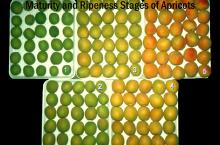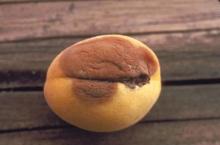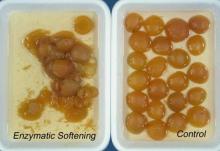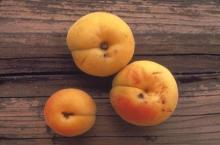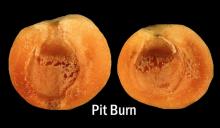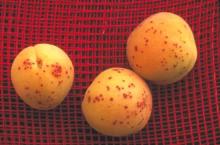Product Description
Maturity and Quality
In California, harvest date is determined by skin ground color changes from green to yellow. The exact yellowish-green color depends on the cultivar. Apricots should be picked when still firm because of their high bruising susceptibility when soft. Most apricot cultivars soften very fast making them very susceptible to bruising and subsequent decay.
- Fruit size, shape, and freedom from defects and decay.
- High consumer acceptance is attained for fruit with high (>10%) soluble solids content (SSC) and moderate acidity (0.7-1.0%).
- Apricots with 2-3 pounds-force flesh firmness are considered "ready to eat".
- Apricot cultivars have a rapid rate of fruit softening (3 pounds-force per day at 20°C (68°F).
Postharvest Handling and Storage
-0.5 to 0°C (31-32°F) is recommended.
Susceptibility of cultivars to freezing injury depends on SSC, which may vary from 10-14%. Highest freezing point = –1.0°C (30.5°F).
90 to 95%
| Temperature | 0°C (32°F) | 10°C (50°F) | 20°C (68°F) |
| ml CO2/kg·hr | 2-4 | 6-10 | 15-25 |
To calculate heat production, multiply ml CO2/kg·hr by 440 to get BTU/ton/day or by 122 to get kcal/metric ton /day.
Ethylene production rates increase with ripening and storage temperature.
Exposure to ethylene hastens ripening (as indicated by softening and color changes from green to yellow). Also, ethylene may encourage growth of decay-causing fungi.
The major benefits of CA during storage/shipment are to retain fruit firmness and ground color. CA conditions of 2-3% O2 + 2-3% CO2 are suggested for moderate benefits; extent of benefits depends on cultivar. Exposure to <1% O2 may result in development of off-flavors and > 5% CO2 can cause flesh browning and loss of flavor.
Physiological and Physical Disorders
Gel Breakdown or Chilling Injury. This physiological problem is characterized in the earlier stages by the formation of water-soaked areas that subsequently turn brown. Breakdown of tissue is sometimes accompanied by sponginess and gel formation. Fruit stored between 2.2-7.6°C (36-46°F) have short market life and lose flavor. Market life is also related to cultivar.
Pathological Disorders
Brown Rot. Caused by Monilia fructicola is the most important postharvest disease of apricot. Infection begins during flowering. Fruit rots may occur before harvest, but often occur postharvest. Orchard sanitation to minimize infection sources, pre-harvest fungicide application and prompt cooling after harvest are among the control strategies.
Rhizopus Rot. Caused by Rhizopus stolonifer occurs frequently in ripe or near-ripe apricot fruits held at 20 to 25°C (68 to 77°F). Cooling the fruit and keeping them below 5°C (41°F) is very effective against this fungus.
References
References from scientifically validated sources will be added in the future.




